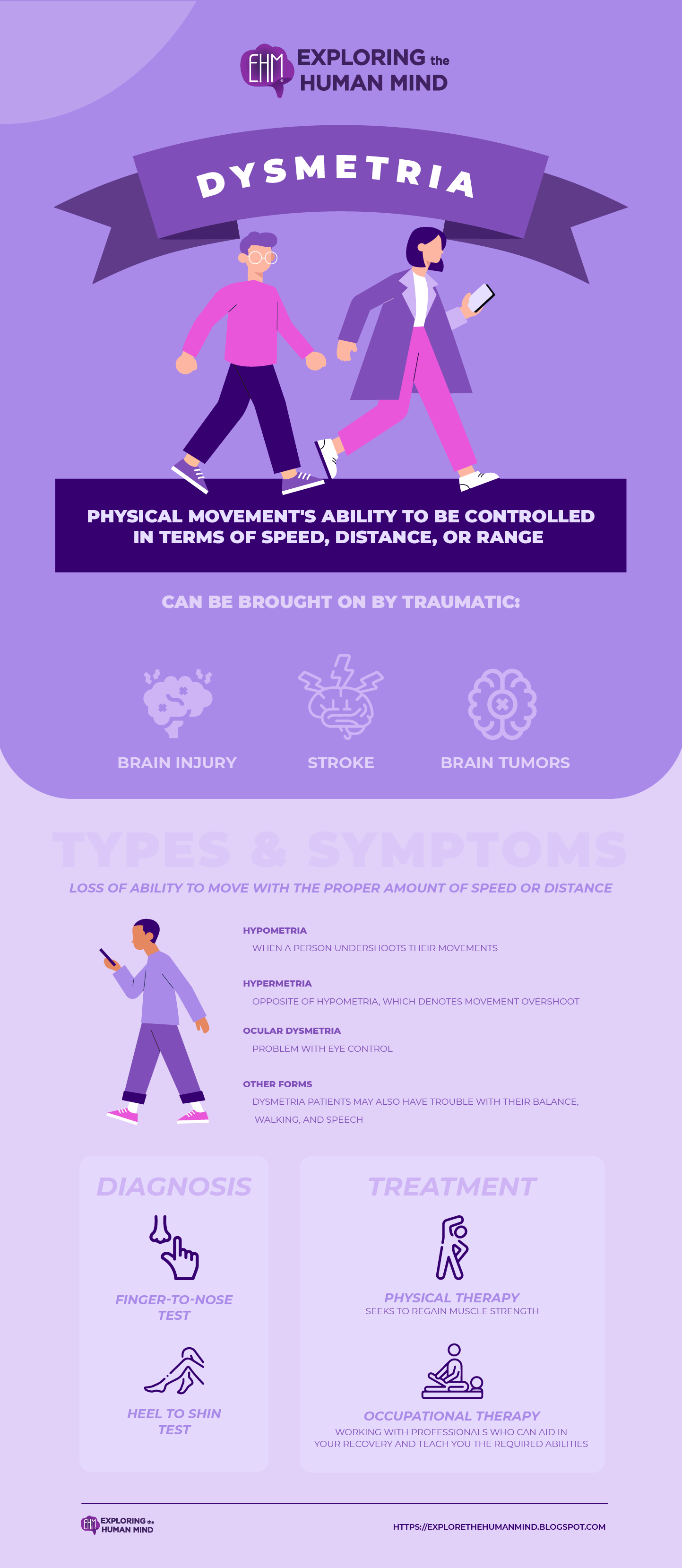Dysmetria
Causes
When the cerebellum, a region of the central nervous system that integrates visual, spatial, and other sensory inputs with motor control to coordinate and plan movement as well as maintain balance, is damaged, dysmetria is a usual outcome. Damage to the cerebellum or to the nerves that carry sensory information to it can make it difficult to determine when and where movements should stop; this difficulty is referred to as undershooting or overshooting.
An injury to the cerebellum or the nerves that connect to it can cause dysmetria. To coordinate and plan movements, this area of the brain analyses visual, spatial, and other sensory inputs. Additionally, the cerebellum aids in maintaining balance.
The following illnesses and trauma can harm the cerebellum:
- traumatic brain injury
- stroke
- brain tumor
- encephalitis, or inflammation of the brain
- cerebral palsy
- autoimmune disorders
- demyelinating disorders(multiple sclerosis, which damage the protective sheath surrounding the nerves)
- inherited degenerative conditions of the nervous system (Friedreich’s ataxia and spinocerebellar ataxia)
- etabolic diseases, including thiamine (vitamin B1) or vitamin B12 deficiency
Signs and symptoms
Loss of ability to move with the proper amount of speed or distance is one of the main symptoms of dysmetria. This happens because the brain is not properly coordinating movement, not because someone unintentionally misjudged their movement.
Dysmetria can involve:
- Hypometria: When a person undershoots their movements, this occurs. They might attempt to reach something, but miss it because their hand is too far away.
- Hypermetria: This is the opposite of hypometria, which denotes movement overshoot. Their hand may extend beyond the object when they are attempting to reach for it.
- Ocular dysmetria: This alludes to a problem with eye control. The eyes may need to switch between two different objects and move again to keep up. Hypometric saccades is the medical term for this condition. As an alternative, the eyes must perform hypermetric saccades to correct an overshoot in order to focus on the intended object.
- Other forms: Dysmetria patients may also have trouble with their balance, walking, and speech.
Due to these challenges, a person with dysmetria may adjust their movements several times in an effort to make them more precise.
Diagnosis
To ascertain whether a patient has dysmetria, doctors can perform a number of coordination tests. They consist of the following:
- Finger-to-nose test In this test, the patient is instructed to extend their arm towards the doctor's finger. They are then instructed to repeatedly touch their own nose.
- Heel to shin test: During this examination, the patient is asked to slide the heel of one foot down the shin of the other leg towards the foot.
These tasks should be simple for a person without a cerebellum injury. However, a person with dysmetria might struggle to maintain control over their movements. While attempting, they might also need to correct their mistakes.
Treatment
Based on the severity of the condition and what caused the cerebellar damage, your doctor will determine the best course of action. Although physical and occupational therapy has helped to improve motor functions, modern science has not yet discovered a permanent treatment for dysmetria.
Physical therapy seeks to regain muscle strength, and occupational therapy entails working with professionals who can aid in your recovery and teach you the abilities required to live a typical life.

vectors by Freepick; graphic design by Vadot
Reference:
Dysmetria: What Is It, Causes, Diagnosis, Treatment, and More | Osmosis. (2019). Osmosis. https://www.osmosis.org/answers/dysmetria
Venkat S.R. (2022, October 18). What Is Dysmetria? WebMD; WebMD. https://www.webmd.com/brain/what-is-dysmetria
Hellicar, L. (2022, October 18). Dysmetria: Causes, testing, and treatment. Medicalnewstoday.com; Medical News Today. https://www.medicalnewstoday.com/articles/dysmetria#summary






Comments
Post a Comment